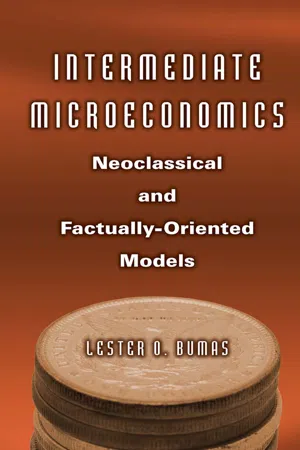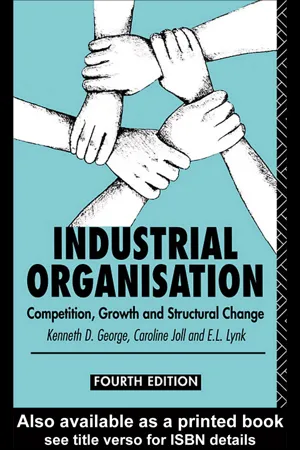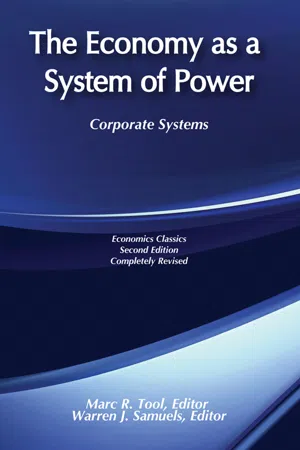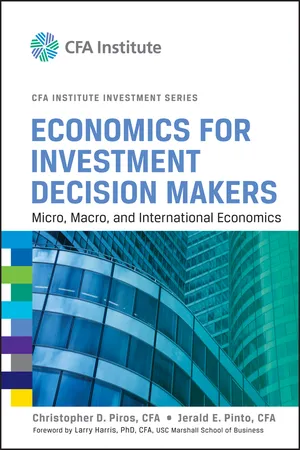Economics
Oligopoly
Oligopoly is a market structure characterized by a small number of large firms dominating the industry. These firms have significant market power and can influence prices and output levels. Oligopolies often engage in strategic decision-making, such as price leadership or collusion, and their actions can have a significant impact on market dynamics and consumer welfare.
Written by Perlego with AI-assistance
Related key terms
11 Key excerpts on "Oligopoly"
- eBook - ePub
Intermediate Microeconomics
Neoclassical and Factually-oriented Models
- Lester O. Bumas(Author)
- 2015(Publication Date)
- Routledge(Publisher)
Consider more deeply the boundaries of a market. There may be hundreds and sometimes thousands of retail stores selling the same product in a metropolitan region such as New York City. But much shopping takes place in a given neighborhood in which there are only a small number of stores for various kinds of common products: a few groceries, a couple of bakeries, three green grocers, a few banks, a couple of hardware stores, two gas stations, two auto repair shops, and several restaurants with only one or two of a particular culinary type. Each knows the existence of rivals selling close substitutes and, I suspect, pays some attention to their activities. These very small firms are also quasi-oligopolies.By the way, Adam Smith was well aware of the significance of the size of the market. His chapter “That the Division of Labour is Limited by the Size of the Market” indicates this. In a small market, he asserted, the country carpenter “is not only a carpenter, but a joiner, a cabinet maker, and even a carver in wood, as well as a wheelwright, a ploughwright, a cart and waggon maker” (1937, [1776], p. 17).Summary on Oligopoly
Oligopolies are large firms which dominate an industry and are rival conscious. Some of our most important industries are dominated by oligopolies. Cournot’s duopoly model is the oldest of those attempting to indicate the effect of a rival on the decision-making of a firm. Sweezy’s kinked demand function, based upon the assumed reactions of rivals, helps to explain the tendency of Oligopoly prices to be sticky—to respond slowly to changes in supply and demand. Game theoretic models attempt to add to our understanding of the strategic actions made in the context of expected responses and sometimes independent actions of rivals.Concentration ratios are a measure of the extent of monopolization in a market. The traditional four largest firm measure has many imperfections, some of which are resolved by the Herfindahl-Hirschman concentration index.Price leadership frequently evolves in lieu of price competition. Non-price competition is the norm in stable oligopolies. Their advantage is that some forms of non-price competition are difficult to emulate, some can be hidden from view, and none are as threatening as price competition.Oligopolistic markets have barriers to entry. These arise from the economies of large-scale production, large financial start-up requirements, the need for special hard-to-get resources, and the requirement of special know-how. Technological advances have mixed effects on the development of this market form. Discoveries of value can, on the one hand, lead in the direction of monopolization and, on the other hand, allow for easier entry and an increase in competition. - eBook - ePub
Microeconomic Principles and Problems
A Pluralist Introduction
- Geoffrey Schneider(Author)
- 2024(Publication Date)
- Routledge(Publisher)
Products may be differentiated or undifferentiated: Oligopolistic industries that manufacture goods for consumers (cars, cell phones, etc.) sell differentiated products. Oligopolistic industries that manufacture materials used in the production of other goods, such as inputs like steel or aluminum, tend to produce undifferentiated products.- Dominated by a few huge firms: A handful of giant firms control most of the industry. There may be some smaller firms, but the major dynamics of the market revolve around the interplay between the dominant firms.
- Significant barriers to entry: In manufacturing, economies of scale are so significant that only huge firms with access to the latest technology and a global supply chain can compete. In consumer goods, brand name recognition and first mover advantages (where consumers get comfortable with a particular product, such as Facebook or the iPhone) allow certain companies to dominate. It is extremely difficult for new firms to enter such markets.
- Interdependence among firms: When a handful of firms dominate an industry, the actions of one of the big players have a large and direct impact on the other firms. Firms watch each other very closely and try to match price cuts and counter advertising campaigns. This also leads to incentives for firms to collude to act like a monopoly, or to merge in order to lessen competition. Most instances of collusion occur in oligopolies.
Strategic considerations in oligopolistic markets are multiple and complex. The importance of size and technology means firms must invest substantially in research and development. The importance of brand name recognition means that there is substantial non-price competition, usually in the form of vast advertising and marketing campaigns. Collusion and mergers and acquisitions are also ways to reduce competition and enhance profits. And oligopolistic firms can secure their position in a market via hiring lobbyists and making donations to campaigns and political action committees to get reductions in taxes and regulations that inhibit their profits. An interesting example of the type of competition we see in an Oligopoly is the Cola Wars and the efforts by Coca-Cola to preserve its market share. - eBook - ePub
Industrial Organization
Competition, Growth and Structural Change
- Kenneth George, Caroline Joll, E L Lynk(Authors)
- 2005(Publication Date)
- Routledge(Publisher)
Chapter 7
Oligopoly pricing
7.1 INTRODUCTION
Chapter 5 looked at different aspects of market structure, and its importance. This showed that market structure is an important determinant of conduct and performance, but that it is necessary to realise both that structure does not rigidly determine performance, and also that structure is not exogenous but can be affected by firms’ behaviour. Chapter 6 examined the market structure which is closest to the textbook case of simple monopoly—i.e. dominance. In this chapter we move on to consider industries which can be described as oligopolistic and focus attention on pricing behaviour in these industries. An oligopolistic industry contains a small number of firms, which means that the effect of any action taken by one of the firms will depend on how its rivals react. For instance, a price cut by one firm will result in a larger increase in sales if the other firms in the industry maintain their existing price than if they all follow its example.It is this interdependence which is the defining characteristic of Oligopoly and which makes the analysis of oligopolistic industries so much more difficult than that of either more concentrated (monopoly) or less concentrated (competitive) industries. Yet it is very important to be able to understand the behaviour of firms in oligopolistic industries because so many markets in advanced economies consist of a relatively small number of firms who are intensely aware of their rivals’ reactions to any competitive move.Monopolies or dominant firms are able to decide on their pricing and other policies without worrying about the reactions of any other, smaller, firms in the market. In oligopolistic markets, firms have a certain amount of scope for independent action, but are constrained by their rival firms to an extent which depends on, among other things, the number and size of the oligopolists and the similarity of their products. This chapter considers only price-setting behaviour, and only as influenced by competition among existing competitors. Other important aspects of oligopolistic behaviour include: product differentiation (Chapter 8 ), and research and development (Chapter 9 - No longer available |Learn more
- Bonnie Nguyen, Andrew Wait(Authors)
- 2015(Publication Date)
- Routledge(Publisher)
15 OligopolyDOI: 10.4324/9781315690339-1515.1 Introduction
We now turn to the case of Oligopoly, a market that contains a small number of firms. Because there are only a handful of key producers in the market, the decisions of each firm have ramifications for not only itself but also for each of its competitors. For example, if Dell adjusts its price for one of its laptops, this will generally have an impact on its competitors, such as HP. Similarly, if a department store decides to advertise, it might be able to increase its customer base at the expense of other firms. Given the impact oligopolists have on one another, a firm’s strategic choice – be it price, its output, whether it introduces a new product and so on – will typically depend on what other firms in the market are doing. For instance, a brewer might consider dropping its price following a price reduction from a major beer manufacturer in the same market. In the soft-drink market, following the introduction of a new energy drink by Pepsi, Coca-Cola may choose to respond with its own alternative. In a similar way, if Samsung introduces a new phone handset, Apple will consider what it should do regarding a new version of its iPhone. A pharmaceutical company will consider what new drugs its rivals are trying to develop (and those that they already have patents for) when considering its own research and development programme. This strategic interaction between firms is a key feature of Oligopoly; moreover, this sort of strategic interaction is absent in other market structures we previously studied (perfect competition, monopoly and monopolistic competition).We model strategic interaction in Oligopoly using game theory. We have previously discussed the core concepts and tools of game theory in Chapter 3 . In this chapter, our goal is to illustrate how game theory tools can be applied in the context of an Oligopoly. In doing so, we will highlight a few key examples of how firms in an Oligopoly strategically interact with each other, but our examples will by no means be an exhaustive demonstration of what game theory can tell us in this context. We urge you to familiarize yourself with the contents of Chapter 3 - eBook - ePub
Microeconomics
A Global Text
- Judy Whitehead(Author)
- 2014(Publication Date)
- Routledge(Publisher)
In this chapter, several of the classical or traditional models and the standard models of Oligopoly, including the Game Theory are examined. The more recent developments in the theory of the firm pertaining mainly to the market structure of Oligopoly are left to the next chapter.12.1 Assumptions, Definitions and Summary of Models
12.1.1 Assumptions
There are a number of assumptions that are common to all models of Oligopoly. These are:- The industry consists of a small number of firms. This is understood to be fewer than under the market structure of Monopolistic Competition.
- The goal of the firm is to maximize profit.
- All factors are freely available to the firm at given prices.
- There is a great deal of interdependence (actual and/or perceived).
- The products in the industry may be homogeneous or differentiated.
Reasons for Oligopoly
Typically, Oligopoly exists because of:- Economies of scale in production.
- Economies of scale in advertising or promotion of the product.
- Limited access to raw materials.
- Government controls on access to the market (e.g. permit requirements, etc.).
- Capital barriers to entry.
- Branding and preference barriers or other barriers to entry.
12.1.2 Definitions
Classical or traditional Oligopoly
The term classical Oligopoly is used to distinguish the traditional models from the modern or alternative models of the firm introduced since the 1950s. The non-collusive and collusive models listed above are all part of classical or traditional Oligopoly.Pure and differentiated Oligopoly
Under pure Oligopoly firms produce a homogenous product (e.g. flour, salt). Under differentiated Oligopoly firms produce a differentiated product (e.g. automobiles, refrigerators). These products are usually differentiated by branding. As with Monopolistic Competition, the differences may be real or fancied. However, they must be such that the consumer perceives the products to be different.12.1.3 Model summary
The various traditional or classical models of Oligopoly may be grouped into the two major classes of non-collusive and collusive. The game theory approach to modelling Oligopoly in terms of competitors in a game with strategies and counter-strategies may be included among the traditional models. The models may be summarized as follows. - eBook - ePub
The Economy as a System of Power
Corporate Systems
- George Sternlieb(Author)
- 2017(Publication Date)
- Routledge(Publisher)
15 Oligopolistic Cooperation: Conceptual and Empirical Evidence of Market Structure EvolutionJohn R. Munkirs and James I. SturgeonIn this article we introduce the concept of oligopolistic cooperation based on structural intradependence, and propose it as a more accurate description of the industries that comprise the industrial core of the U.S. economy. Many economists agree that Oligopoly is the most prevalent market structure in the United States and other industrialized countries.1 This is especially true in finance, mining, and manufacturing. Even though the chief characteristics of Oligopoly are “few” firms and psychological interdependence among these firms, it is usual to characterize their behavior as competitive, although not always via price. This characterization of their behavior suggests the name “oligopolistic competition.”Here we distinguish between oligopolistic competition and what we call oligopolistic cooperation.2 Specifically, cooperation is intended to signify behavior that goes beyond coordination or “unconscious parallelism.” And, while cooperation is similar to coordination in some respects, there are fundamental differences. The primary difference is that in oligopolistically cooperative industries specific, legally binding, quasi-permanent organizational structures exist. In turn this type of organizational structure provides not only the means but the necessity for cooperative behavior. Cooperative behavior, in turn, has profound implications for the relevance of micro and macro economic theory as well as public policy.Oligopolistic Competition: The Standard ViewLeading Oligopoly theorists such as Fritz Machlup and E. H. Chamber-lain have argued that as a result of mutual interdependence the basic problem facing oligopolists involves the reaction of competitors to each others' price, quality, production, and capacity decisions. Fewness creates a psychological awareness and intense rivalry absent in other market structures. More than thirty years ago Machlup made the point as follows: - eBook - ePub
Economic Principles and Problems
A Pluralist Introduction
- Geoffrey Schneider(Author)
- 2021(Publication Date)
- Routledge(Publisher)
Dominated by a few huge firms: A handful of giant firms control most of the industry. There may be some smaller firms but the major dynamics of the market revolve around the interplay between the dominant firms.- Significant barriers to entry: In manufacturing, economies of scale are so significant that only huge firms with access to the latest technology and a global supply chain can compete. In consumer goods, brand name recognition and first mover advantages (where consumers get comfortable with a particular product, such as Facebook or the iPhone) allow certain companies to dominate. It is extremely difficult for new firms to enter such markets.
- Interdependence among firms: When a handful of firms dominate an industry, the actions of one of the big players have a large and direct impact on the other firms. Firms watch each other very closely and try to match price cuts and counter advertising campaigns. This also leads to incentives for firms to collude to act like a monopoly or to merge in order to lessen competition. Most instances of collusion occur in oligopolies.
Strategic considerations in oligopolistic markets are multiple and complex. The importance of size and technology means that firms must invest substantially in research and development. The importance of brand name recognition means that there is substantial non-price competition, usually in the form of vast advertising and marketing campaigns. Collusion and mergers and acquisitions are also ways to reduce competition and enhance profits. And oligopolistic firms can secure their position in a market via hiring lobbyists and making donations to campaigns and political action committees to get reductions in taxes and regulations that inhibit their profits. An interesting example of the type of competition we see in an Oligopoly is the cola wars and the efforts by Coca-Cola to preserve its market share. - eBook - ePub
- Andrew Barkley, Paul W. Barkley(Authors)
- 2016(Publication Date)
- Routledge(Publisher)
The key characteristics of firms in an Oligopoly are that the firms are rivals even though they form an interdependent group. The behavior of one firm has an impact on the behavior of other firms in the industry. Oligopolists must take into consideration the actions of other firms. Firms in an Oligopoly are considered to have market power, and their ability to set price is determined by their own actions and the actions (and reactions) of other firms in the industry.Taken together, agricultural implement manufacturers operate as an Oligopoly. There is much interdependence within the group. Both price and nonprice competition are prevalent. The John Deere farm implement manufacturer must pay close attention to its rival, Case-IH, if it wants to maximize profits, or even if it wants to stay in business. If one of these giant firms lowers the price of certain lines of implements, the other firm, also a giant, will most likely match the new low price in order to retain its customers. If the price is lowered by both firms, then both firms earn lower levels of profits. Both firms would be better off maintaining a higher price. Similarly, if one firm raises its price, it will lose some customers to the other firm, unless the price hike is matched. Profit levels and market shares are determined by all firms in an Oligopoly, rather than just the one firm acting alone.The central strategy of an oligopolist is to form an alliance with the other firms in the industry to maintain prices at a level higher than the competitive market price. Firms Collude when they agree to make decisions as a group.- Collusion = when firms in an industry jointly determine the price of the good.
Collusion is a form of monopoly. If all of the firms in an Oligopoly agree to act as a single firm, they would be a de facto - eBook - ePub
Economics for Investment Decision Makers
Micro, Macro, and International Economics
- Christopher D. Piros, Jerald E. Pinto(Authors)
- 2013(Publication Date)
- Wiley(Publisher)
When is an Oligopoly not an Oligopoly? There are two extreme cases of this situation. A normal Oligopoly has a few firms producing a differentiated good, and this differentiation gives them pricing power.At one end of the spectrum, we have the Oligopoly with a credible threat of entry. In practice, if the oligopolists are producing a good or service that can be easily replicated, has limited economies of scale, and is not protected by brand recognition or patents, they will not be able to charge high prices. The easier it is for a new supplier to enter the market, the lower the margins. In practice, this Oligopoly will behave very much like a perfectly competitive market.At the opposite end of the spectrum, we have the case of the cartel. Here, the oligopolists collude and act as if they were a single firm. In practice, a very effective cartel enacts a cooperative strategy. As shown in Section 5.1, instead of going to a Nash equilibrium, the cartel participants go to the more lucrative (for them) cooperative equilibrium.A cartel may be explicit (that is, based on a contract) or implicit (based on signals). An example of signals in a duopoly would be that one of the firms reduces its prices and the other does not. Because the firm not cutting prices refuses to start a price war, the firm that cut prices may interpret this signal as a suggestion to raise prices to a higher level than before, so that profits may increase for both.6.1 MONOPOLY
Monopoly market structure is at the opposite end of the spectrum from perfect competition. For various reasons, there are significant barriers to entry such that a single firm produces a highly specialized product and faces no threat of competition. There are no good substitutes for the product in the relevant market, and the market demand function is the same as the individual firm’s demand schedule. The distinguishing characteristics of monopoly are that a single firm represents the market and significant barriers to entry exist . Exhibit 4-1 identified the five characteristics of monopoly markets:1. There is a single seller of a highly differentiated product. - eBook - ePub
Introduction to Air Transport Economics
From Theory to Applications
- Bijan Vasigh(Author)
- 2017(Publication Date)
- Routledge(Publisher)
The next step along the market continuum from monopolistic competition is Oligopoly. Oligopoly is most relevant to aviation and will be the focus of the remainder of this chapter. Unlike firms in perfect competition or monopolistic competition, the oligopolist’s actions will substantially affect the market. In turn, this may alter the actions of other competitors. This creates a complex interdependence amongst the firms; each firm’s actions will be conditioned on how they believe the competition will react. For example, an airline might be more likely to reduce fares if it thought that competitors would leave their fares unchanged, but would prefer to leave fares constant if it believed that competitors would instantly match price cuts. Thus, each airline’s pricing is based, in part, on what it believes competitors will do. Clearly, this is a complex problem, and one that often presents no clear, optimal strategy.It follows, then, that almost any short-run outcome is theoretically possible in Oligopoly. Firms might, for instance, sometimes practice “tacit collusion,” where they keep prices relatively high and “go along to get along” by avoiding any aggressive competitive act that would lead to price wars. On the other hand, Oligopoly can, as seems to often be the case for airlines, produce aggressive “cut-throat” competition where the typical firm is routinely operating in the red.Figure 9.3 Longer-run equilibrium: monopolistic competitive marketWhereas normal long-run profits are a given in monopolistic competition, it is theoretically possible for long-run profits to be above normal in Oligopoly if there is a sufficiently insurmountable barrier to entry. Currently, though, many oligopolies, including such former paragons as General motors, seem to struggle just to earn normal long-run profits. Indeed, most legacy airlines’ long-run profits have been well below normal. Nevertheless, there are usually barriers to entry of some sort in Oligopoly markets, so the number of competitors is relatively small. These barriers include high start-up/fixed costs, the existence of sizeable economies of scale, control over scarce resources, or exclusive patent/legal rights.Oligopoly is often viewed as inherently undesirable—better than monopoly, but not nearly as good as perfect competition. While most economists would probably agree that there is a certain degree of truth in this perspective there are some complications. A few large firms can often enjoy economies of scale and thereby produce at far lower costs and sell profitably at far lower prices than could an industry composed of smaller, more numerous firms. This is easy to see in the case of aircraft production. It is far cheaper for Boeing or airbus to develop and produce 1,000 aircraft than it would be to have 100 small manufacturers develop and produce ten comparable aircraft each. Boeing or airbus can spread research and development costs over more units, thus pricing them lower, and can benefit from the experience gained, becoming increasingly efficient with each additional aircraft produced. There is no doubt that airlines and air travelers are better served by having two, rather than 200, manufacturers of large aircraft. Economies of scale, scope and density are also important in the airline industry; so, again, we are probably better off with an airline Oligopoly than any feasible alternative. - eBook - ePub
Experimental Economics
Volume II: Economic Applications
- Pablo Branas-Garza, Antonio Cabrales, Pablo Branas-Garza, Antonio Cabrales(Authors)
- 2016(Publication Date)
- Palgrave Macmillan(Publisher)
2 Non-Competitive Markets Nikolaos Georgantzís and Giuseppe Attanasi IntroductionA market is not competitive when the agents acting in such a market have the power to influence the price, directly or indirectly, something that does not occur under perfect competition. Generally, these agents have market power because they are few in number, have access to relevant information and can foresee the interdependence between their strategies and those of others.Among all the paradigms in economic theory, the theoretical predictions of Oligopoly were the first to be examined in the laboratory. In the origins of experimental economics one can find the works of Chamberlin (1948) and of Smith (1962, 1964), who designed experiments to study a market with few agents that could reach the competitive equilibrium (see Chapters 1).In this chapter, instead of surveying all experiments with few sellers,1 we will adopt a narrower definition of the term “Oligopoly ,” and will focus on experiments that were directly inspired by the basic oligopolistic models of Cournot (1838), Bertrand (1883), Hotelling (1929), von Stackelberg (1934), and similar. We will omit, therefore, other experiments, such as those of Chamberlin and Smith, which were designed with the aim of testing the predictive power of the competitive equilibrium model.Most of the experiments we consider in this chapter have been run in the last three decades.2 This literature can be considered as a new wave of experimental work, aiming at representing basic oligopolistic markets and testing their properties. This work represents a systematic attempt to study a similar, but not identical, question to that tackled by Chamberlin (1948) and Smith (1962, 1964). While the latter compared the results in the laboratory with predictions of the competitive equilibrium , the series of experiments we review here compare observed behavior with the corresponding oligopolistic equilibria
Index pages curate the most relevant extracts from our library of academic textbooks. They’ve been created using an in-house natural language model (NLM), each adding context and meaning to key research topics.










